
Proving the Market and Getting a Plan

NOW THAT YOU HAVE A HANDLE on your state’s cottage food law, set your personal goals for your business, sorted out some possible recipes that might work and embraced the 7 Ps of marketing, it’s time to test the market, size up your competition and commit your plan to paper. These final steps are covered in this chapter.
Market Feasibility: Testing the Market
While you may have a great-tasting product, you still have to test it in the marketplace. It’s one thing if everyone you know loves your muffins — especially, if they’re free. It’s something completely different to see if customers will buy them at two dollars a pop. The same holds true for your organic pickles, which you calculated should retail for about twelve dollars a jar.
This process of testing the market for your products is often called a feasibility study; it may take the following route:
(1) Testing
This may involve evaluating taste, pricing, portion size, packaging, the label and even the sales venue itself.
(2) Feedback
Provide comment cards, send short online product surveys, or have a system in place where you can jot down or collect comments you receive from customers about your product. While some feedback may echo what your customers think you want to hear (not what you really want), other times it could highlight an issue, sometimes in a brutally honest way.
Besides reaching out directly for feedback, you can also explore incidental sources of information about your most promising markets. How are other food enterprises selling their products? Having some competition is a great thing, since that means there’s a market for what you want to sell. Evaluate each of the 7 Ps of marketing in relation to your competitors to determine how your products are different — and better.
(3) Refinement
Take what you’ve learned, by way of direct customer feedback or observing decisions made by your customers or the marketplace, and refine, modify or adjust your product and marketing accordingly. For example, did your blueberry muffins sell out in the first hour, but you returned home with your wild cherry version? Did a volume discount pricing strategy for your gift jellies allow you to profit more by selling a greater volume than if you sold them all one at a time at full price? Did a flavor sampler set sell better than a four-pack of the same flavor?
Keep refining until you’ve reached a level of confidence before launching your product. Remember, you need to have a product that enough customers want and are willing to pay for at a fair price, to leave you with enough profit at the end of the day to make it worth undertaking.
(4) Product Launch
Finally, synthesize your testing, feedback and refinement into your final product and implement your launch campaign.
Keep in mind, however, that change is constant. Customers can be fickle, follow trends and fads, or have tastes that change. One year, gluten-free is the rage; three years later, it’s sugar-free or low-sugar. In most cases, even though your feasibility study may reveal solid products to market, it’s always possible that market conditions will change, a new competitor will show up across from your booth or some of your key customers will move away.
The food industry, especially specialty food products, can be cyclical and very sensitive to economic booms and busts. By their nature, many of these food items are perceived as impulse purchases. A breakfast of chocolate croissants is not the same thing as a hearty spaghetti dinner in the eyes of many, even if both cost about the same.
Be realistic, flexible and adaptable with your products and marketing and you’ll do just fine. And keep listening to the needs of your customers. They might just point you in the direction of the next great thing.
Name: Regina Dlugokencky
Business: Seedsower Farm (Centerport, New York)
Website: seedsowerfarm.com
Products: sourdough bread, jam, sourdough popovers, focaccia
Sales venue: farmers’ market
Annual Sales: $3,000
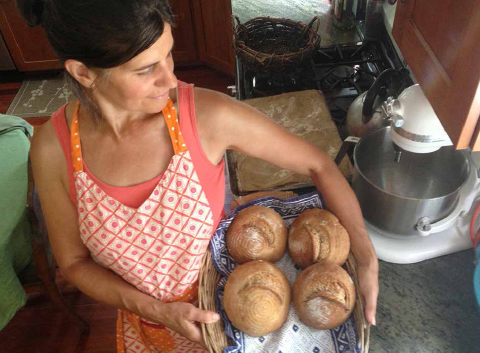
Seedsower Farm owner Regina Dlugokencky holding her fresh-baked bread. COURTESY OF SEEDSOWER FARM
Fermenting Dough with Home-Baked Bread
“I’m a small-scale nano-farmer looking to keep the income going in the winter,” shares Regina Dlugokencky, owner of Seedsower Farm, a little market farm operation in Long Island, New York. What started as an afterthought to the farming season fermented into a bread-making obsession for this self-taught baker. “You could say I’ve built a nice little cult following for my bread,” she adds. “I’m now known as ‘the organic bread girl’ at our farmers’ market.”
Dlugokencky sells sourdough breads along with organic jams every Sunday from December though April at the Long Island Winter Farmers’ Market in Huntington Station, New York. Using only organic ingredients and New York State flours, she quickly discovered the sweet spot in starting a bread business: all you need is flour and yeast, and, with a fresh product like bread, you can start super-small and test market demand for different products and adapt as you move along.
“The first time I experimented with bread at the market, I just brought six loaves. I used one for sampling and quickly sold the other five. I was hooked on the potential.” Like many cottage food operators, Dlugokencky used the farmers’ markets as “test markets” for her products, examining customer preferences and sensitivity to price and gauging demand.
Today she bakes thirty to forty loaves each week. The loaves sell for between $5.00 and $6.50 each. In the spring, Dlugokencky also raises organic vegetable garden plants. Her other growing season focus is raising crops that will serve as additional products for the winter markets, such as berries for her jams and storable alliums like garlic, shallots and specialty onions. She cures these to sell at the winter markets.
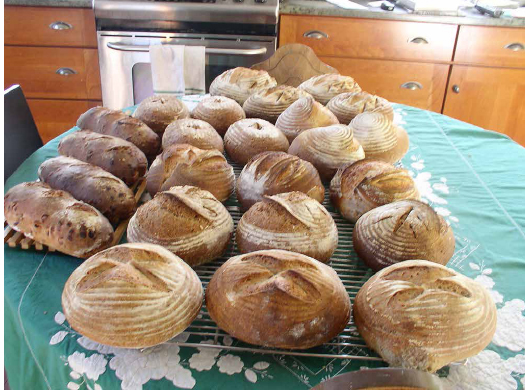
Seedsower Farm’s artisanal breads, ready for packing for market. COURTESY OF SEEDSOWER FARM
Blending efficiency and a dedication to frugality, Dlugokencky creates various systems and organizational techniques to turn out loaves from her small kitchen. “I didn’t go out and buy everything right away when I started. Instead, I tapped into friends’ offers to help. It amazed me how many folks owned multiple KitchenAid mixers and were happy to let me borrow theirs.” The morning before market, she makes the dough, using a sourdough starter instead of yeast, which gives the bread that desirable tangy taste and crusty texture. She lets the KitchenAid mixer do the heavy work of kneading. The dough is then placed in large containers for the long, first rise.
After an initial rise of three to four hours, she divides the dough and weighs each piece on a scale for consistent loaf size, finding that her customers generally like a smaller loaf (weighing about a pound after baking). After a short rest time, she shapes the loaves and places the divided dough in various bowls, covers them with plastic wrap, and places them in the refrigerator for the final, slow rise overnight. “When I first began baking, the bowls were nothing special, just what I already had on hand,” she says. But once she found the market for her bread was viable, she invested in proofing baskets. “I want to keep the product accessible to the most number of people, so I place my investment in the ingredients and try to be resourceful with everything else.”
At 2 am the next morning, Dlugokencky’s morning baking is in full swing. She preheats the oven and removes the loaves from the refrigerator, where they’ve been since the day before, to come back to room temperature. To make a 10 am market start, she then bakes from 3:00 to 8:30 am.
“I highly recommend using proofing baskets instead of bowls for the final rise. The baskets will make your loaf look phenomenal, like it came out of a professional bakery,” advises Dlugokencky. Proofing baskets, also called bannetons, come in every shape and size — round, oval or long. Sprinkle the basket generously with flour and place the dough inside for the final rise. The lines and pattern of the basket will imprint on your dough in a beautiful pattern. Flip the dough out after it has risen and you’re ready to bake.
“My biggest challenge is baking all the bread in my kitchen in time for market. I killed my first oven three times, perhaps due to volume, and finally invested in a large 5.6-cubic-feet oven with convection. Now I can bake eight loaves at a time.” She thoroughly researched models and corresponding reviews before deciding on a Kenmore that met her $1,000 budget. “I actually considered buying a commercial oven, but the electricity would have to be redone, and, technically, a home processor’s license in New York disallows use of professional equipment.”
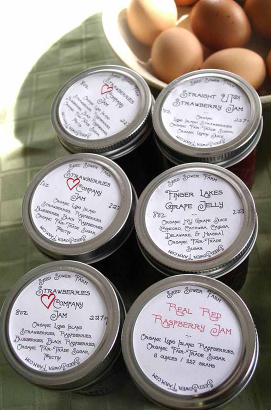
There’s nothing like Seedsower Farm’s jam to go with fresh-baked bread. COURTESY OF SEEDSOWER FARM
“At market, let your customers pick out which loaf they like,” Dlugokencky suggests. “It’s an easy way to add that personal touch and interact with them.” She also makes a few batches of onion focaccia and sourdough popovers, which she sells individually. These add a tempting impulse purchase since they’re something her customers can eat right away while taking the loaf of bread home.
“I prepare jams from the summer berry harvest, but I confess I like making bread better. The jam is a much smaller side business of less than 20 percent of my total sales,” adds Dlugokencky. In addition to the berries she grows herself, she buys local, organic fruit in bulk in season and freezes it to make jams during the winter. She does charge a $1.50 deposit for the jar to keep the costs down and finds customers have no issue with that, even though she rarely gets the jar back. As a vendor at the Long Island Farmers’ Market, Dlugokencky must carry both general and product liability insurance which she gets through Farm Family Insurance for a couple hundred dollars a year.
“Start small and keep learning,” Dlugokencky advises. “Once you find out what you like to do, like me with bread, fine-tune your recipes and don’t be afraid to fail. The first loaf of bread I made doesn’t compare to what I can pump out in multiple batches every week now. It took practice and some mess-ups along the way.”
Dlugokencky’s frugal nature embraces and celebrates the failures: any bread not fit for eating makes great breadcrumbs or croutons!
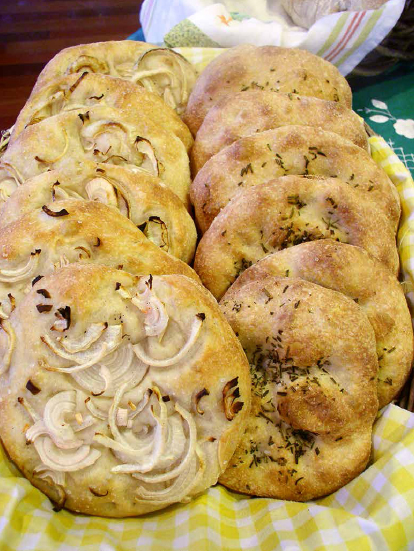
The focaccia baked by Regina Dlugokencky gives her customers a chance to snack while at the market. COURTESY OF SEEDSOWER FARM
Garnering Feedback
As a small CFO, you don’t need to spin wheels and spend lots of money to figure out the value and sales viability of your product. Depending on your products, options to connect with your customers and garner actionable information may include:
• Follow-up e-mails requesting customer comments or feedback.
• Testing out products at mini-markets. By selling at small sales venues to test the waters with your product, you can adjust various marketing approaches, including price, to determine the potential for your product.
• Snail mail a letter with a small survey to return in a self-addressed stamped envelope.
• Try out the widely used Survey Monkey (surveymonkey.com), a free online system that allows you to invite customers to complete a survey about your products; SurveyMonkey provides various analytic tools to ferret out key insights.
• Large marketing companies often use focus groups, inviting potential customers to taste samples and offer their opinions. You could do something similar, perhaps in a less formal way at your home or a “community room” at your local library, if they permit it.
Regardless of how you collect feedback, make sure you incentivize your customers’ participation. As thanks, perhaps offer a giveaway draw for your products. In your early market feasibility study, you may want to avoid social media until you’re satisfied with your products and feel comfortable that the public feedback you receive will generally be favorable. Ideally, minimize the possibility of customers railing or venting negatively about your product, especially if you’re still refining your recipe or the marketing. If you’ve ever read restaurant reviews on Yelp or Trip Advisor, you’ll recognize the power of one that’s well written but scathing.
Early on in your product development, you’ll need to undertake some form of competitive analysis, carefully examining the potential markets for your products. This will give you a sense of what other companies are selling and how their products are the same as or similar to what you want to offer. Observe pricing, product features and other marketing aspects.
Competitive analysis can be informal, via the Internet, or merely anecdotal, perhaps as you browse the aisles of a local farmers’ market or arts and craft show, jotting down notes on the selection, pricing and quality of baked goods. An easy way to record your findings is by creating a chart or matrix that lists other companies and their products, along with any distinguishing characteristics or special features.
Many enterprises come about because a particular food product is completely missing where they’re located. Perhaps there are no organic pickles, gluten-free baked goods or decorative cakes made in a nut-free kitchen. In these cases, you’ll have the opportunity to “own the market” and be the only one offering such an item. But be warned: this doesn’t guarantee success or mean you can charge anything you want. You’ll still need enough customers in your community who want to buy your product at a fair price to make your enterprise worth undertaking.
The more ambitious your plans and sales goals, the more astute you’ll need to be to details, competition and marketing considerations. Understanding your competition is essential to breaking into the market with your products. The more crowded a market, the more you’ll need to find your niche and clearly identify your target audience, both covered previously in Chapter 4.
Finally, the time has come to put it all together. If you’ve followed along in the previous chapters, making notes, testing recipes, coming up with product names, talking with potential customers, and making labels, it’s time to summarize everything in a plan and then put that plan into action.
If you fail to plan, you plan to fail. Some of the most innovative ideas or tastiest recipes never make it to our mouths because the people with them couldn’t get their ideas down on the drawing table or, worse yet, jumped into a business before thinking it all the way through. Please don’t let this happen to you.
Given that most cottage food businesses will have modest or humble beginnings, we’re recommending that you forget about writing a full-blown business plan with a vision statement, company description, product details, strategy…ad nauseum. At this point, you don’t need to impress a bank to get a loan to start your business. It’s too early to tell if your cookies are going to be a ten-thousand or a hundred-thousand-dollar hit.
That said, if you love writing or like to meticulously detail every step, decision and ingredient, by all means do so, but know that such a labor-intensive undertaking is unlikely to make your business more profitable when you’re just starting out. It’s the process of writing the business plan that’s most valuable. It forces you to evaluate every aspect of your enterprise and get these details down on paper.
If the time comes where you need and want to expand, you’ll have plenty of time, enthusiasm and determination then to pull together that business plan that would impress an MBA professor type, lure money from the deep pockets of bankers and convince the rest of your family you’re serious about turning your cottage food business into a big business, covered in the last section of this book. There are plenty of free online resources that guide you through the steps of writing a business plan, from a vision statement to pro forma income statement and balance sheet. In case you’re curious, here are a few that you can customize for your needs: enloop.com, score.org; sba.gov (follow the link to writing a business plan).
Besides providing resources for small businesses, the Association for America’s Small Business Development Centers (asbdc-us.org) offers a small business assistance network in the United States and its territories. The network’s mission is to help new entrepreneurs realize their dreams of business ownership. Small business owners and aspiring entrepreneurs can go to one of approximately a thousand local SBDCs for free, face-to-face business consulting and at-cost training on writing business plans, marketing or regulatory compliance. For the non-profit Business Alliance for Local Living Economies (BALLE), it’s all about being a “localist.” Their mantra: “Changing the way our economy operates starts with a single person. It starts with you. We believe that real national prosperity begins at the local level.” BALLE recognizes that local independently owned businesses are the key to solving communities’ toughest challenges and to creating real prosperity. BALLE (bealocalist.org) connects visionary local leaders so they can find inspiration and support; they’re another place to go to expand your market for cottage foods and network with others with similar interests.
But for now, let’s go with what we call the “back-of-a-napkin plan” that, if nothing else, makes sure you don’t forget the great ideas you’ve come up with to get your product to market. Plus, it might keep you on track. As an example, the adjacent sidebar provides a sample napkin-sized plan for our Inn Serendipity FRESH BAKED business, specific to our state’s pending cottage food law; a general template is on this book’s website.
When searching for resources to help you launch your business, you’ll sometimes notice a bias against being your own boss or becoming an entrepreneur, especially at universities where tenure is still practiced. Our mantra: give your business idea a shot, get a plan together and go for it. So, take any negative vibes you might encounter in stride and recognize the source. It could be coming from an ivory tower.
Inn Serendipity FRESH BAKED
Products: Biscotti, granola, organic muffins, bagels, granola bars
Sales Objective: $2,000, ramping up to Wisconsin’s cap of $10,000 gross sales
Target Markets:
• Primary: Inn Serendipity Bed & Breakfast guests; direct on-farm sales
• Secondary: Attendees at various community events; direct-to-customer sales at a booth
Niche: Baked products made with organic and locally sourced ingredients, containing no artificial flavors, colors or preservatives
Positioning Statement: Inn Serendipity FRESH BAKED offers discriminating foodies great-tasting, truly homemade, organic and locally baked goods that contain no artificial flavors, colors or preservatives. These premium-priced products are unlike any available in the Monroe, Wisconsin, area.
Sales Venues: On-site, plus some high-traffic, low-competition community events during the low season, like Monroe Cheese Days and Monroe Gem and Rock Show
Start-up expenses: $25 total, for cottage food license ($10) and required online food safety training course ($15). The equipment and business registrations (sales tax = $10); state license ($65) and registered office registration ($25), are already covered as a part of Inn Serendipity B&B.
Fixed expenses: $0, liability insurance covered by existing homeowner policy from Cincinnati Insurance Company as a part of the B&B; the B&B is listed as “incidental to the home” and comes with an annual premium of $69. Additionally, $1 million umbrella liability insurance policy is also taken, costing $165 per year. DSL Internet service ($34/month), domain name ($10/year) and website hosting ($120/year) already covered as a part of the business.
Here’s how one less-than-positive start-up guide written by Kenneth W. Wood from the Mississippi State University Extension Service puts it:
“Do I want a hobby, or do I want to make money?” It is very difficult to introduce a new product into the market place. In many instances, it would be better to take the money required to start such a business and invest it in a certificate of deposit.
Oh, really? Last we checked, you can earn only .99% APY on a CD for one year; for a $500 investment, you’d get back $4.95 in interest earnings. We don’t know a cottage food business on the planet that couldn’t beat that.
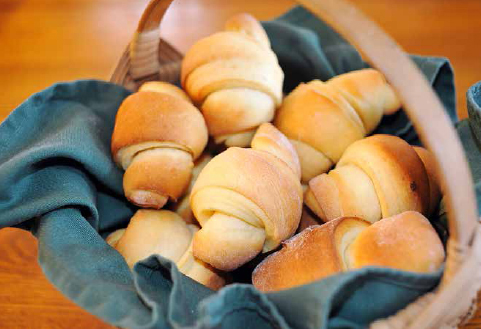
Don’t let anyone discourage your enthusiasm for making some dough — both figuratively and literally — with fresh baked dinner rolls. JOHN D. IVANKO